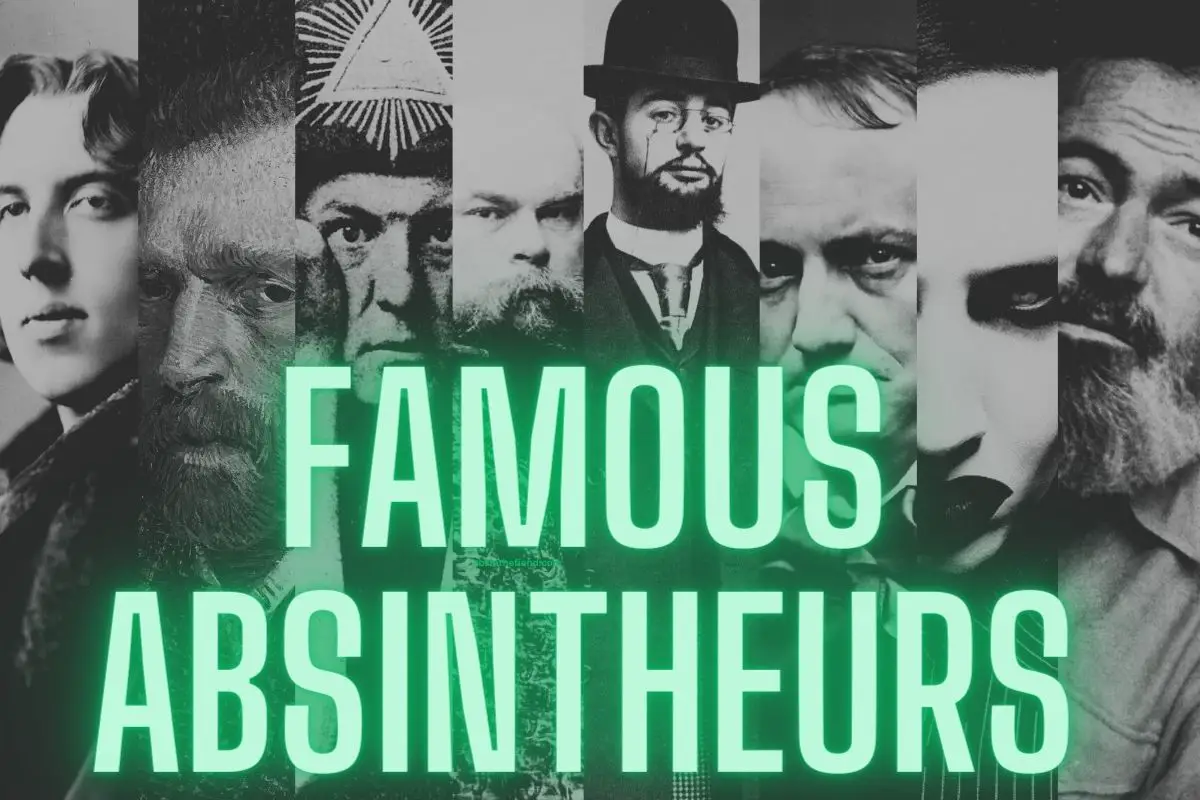Dive into the emerald depths of history’s most enigmatic beverage with this feature celebrating history’s most famous absinthe drinkers!
From the shadowy cafés of 19th-century Paris to the rock stages of the 21st century, absinthe has whispered its secrets to a select circle of the world’s most brilliant and rebellious minds.
Whether it was the green muse for poets like Arthur Rimbaud or the bottled inspiration for rock icons like Marilyn Manson, this potent potion has been a silent partner in the creation of masterpieces.
Join us as we unveil the allure that drew the likes of Ernest Hemingway, Vincent van Gogh, and Oscar Wilde into its intoxicating embrace.
Sip responsibly as we recount tales of genius tinged with madness, all linked by the legendary “Green Fairy.”
Vincent Van Gogh
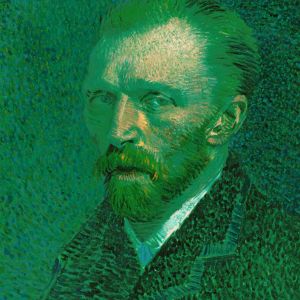
Vincent van Gogh was a Dutch post-impressionist painter who is among the most famous and influential figures in the history of Western art.
Born on March 30, 1853, in Zundert, Netherlands, van Gogh created about 2,100 artworks, including around 860 oil paintings, most of which date from the last two years of his life. His works are characterized by bold colors and dramatic, impulsive, and expressive brushwork that contributed to the foundations of modern art. Some of his most notable works include “Starry Night,” “Sunflowers,” and “The Potato Eaters.”
Van Gogh’s relationship with absinthe is well-documented, partly due to the drink’s popularity among artists and writers in the late 19th century. Absinthe was known for its high alcohol content and was believed to stimulate creativity, which made it a favored drink in artistic circles.
Van Gogh was known to frequent Parisian cafes where absinthe was commonly consumed. It has been speculated that his consumption of absinthe, which contains thujone, might have contributed to his mental health issues and the vivid yellow hues seen in some of his paintings, like “Sunflowers.”
However, it is important to note that the role of absinthe in van Gogh’s life is often romanticized, and its actual impact on his health and work remains a subject of debate among scholars.
Nevertheless, van Gogh is synonymous with The Green Fairy and you’ve likely seen his work referenced throughout the absinthe world, perhaps most famously on the marketing materials for Absente.
Oscar Wilde

Oscar Wilde was a renowned Irish playwright, novelist, essayist, and poet who became one of London’s most popular playwrights in the early 1890s.
Born on October 16, 1854, in Dublin, Ireland, Wilde is best known for his sharp wit, flamboyant style, and brilliant conversational skill.
Wilde’s writing is marked by its eloquent dialogue, satirical wit, and exploration of themes like decadence, duplicity, and beauty.
His literary works include the novel “The Picture of Dorian Gray,” a tale of moral corruption and the only novel he published, and plays such as “The Importance of Being Earnest” and “An Ideal Husband,” which are celebrated for their satirical take on Victorian society.
Wilde’s consumption of absinthe is part of his legend as a bon vivant and a man of great taste and excess. He was a part of the fin de siècle society in Paris, where absinthe was very much en vogue among artists and intellectuals.
Wilde famously described the experience of drinking absinthe saying: “After the first glass, you see things as you wish they were. After the second, you see them as they are not. Finally, you see things as they really are, and that is the most horrible thing in the world.”
His fondness for the drink reflects the bohemian lifestyle he led, particularly during his time in Paris, where absinthe was considered a symbol of artistic freedom and rebellion against social norms.
It is important to note, however, that while Wilde’s consumption of absinthe is noted, it is just one aspect of his rich and complex life.
Recommended: Debunking Absinthe Myths
Ernest Hemingway

Ernest Hemingway was an American novelist, short-story writer, and journalist renowned for his economical and understated writing style—a technique he termed the “iceberg theory,” which had a strong influence on 20th-century fiction.
Hemingway’s adventurous lifestyle and his public image as a man of action greatly influenced the later generations.
Born on July 21, 1899, in Oak Park, Illinois, he served in World War I as an ambulance driver and later worked as a journalist before turning to fiction. His notable works include “The Old Man and the Sea,” “A Farewell to Arms,” “For Whom the Bell Tolls,” and “The Sun Also Rises.” Hemingway was awarded the Nobel Prize for Literature in 1954.
Ernest Hemingway had a well-known fondness for absinthe, particularly during his time in Paris in the 1920s, a period when he was part of the expatriate community of writers and artists known as the “Lost Generation.”
Hemingway’s favorite haunts in Paris included cafes where absinthe could be enjoyed.
He even referenced the drink in his works, such as “For Whom the Bell Tolls,” and is credited with creating a cocktail called “Death in the Afternoon,” a mixture of absinthe and champagne.
The drink was so named after his book of the same title and reflects Hemingway’s penchant for strong liquor and his association with the absinthe-drinking tradition among writers and artists of his era.
Recommended: The Rise, Fall, and Rise Again of Absinthe in the U.S.
Charles Baudelaire

Charles Baudelaire was a French poet, essayist, art critic, and a pioneering translator of Edgar Allan Poe.
Born on April 9, 1821, in Paris, France, Baudelaire’s most famous work, “Les Fleurs du mal” (The Flowers of Evil), expresses the changing nature of beauty in modern, industrializing Paris during the 19th century.
His work had a profound influence on the Symbolist movement in poetry with its themes of decadence and eroticism, and he is credited with coining the term “modernity” (“la modernité”) to designate the fleeting, ephemeral experience of life in an urban metropolis and the responsibility that art has to capture that experience.
Baudelaire’s consumption of absinthe was part of a larger infatuation with the bohemian lifestyle that included an interest in drugs and the exploration of altered states of consciousness as a means of gaining artistic insight. He was a member of the Club des Hashischins (Hashish Club), where artists and writers would experiment with drug-induced states.
Though absinthe was popular among many artists and writers of Baudelaire’s time as a source of inspiration and rebellion against social norms, Baudelaire’s own relationship with the drink was complex.
He wrote about wine and opium in his prose poem collection “Le Spleen de Paris” (Paris Spleen), and while he did consume absinthe, his writings suggest a broader and more nuanced exploration of the effects of intoxicants on the mind and creativity.
Baudelaire’s life and work reflect the intersection of intoxication and artistry that was a hallmark of the bohemian artistic communities of the time.
Erik Satie
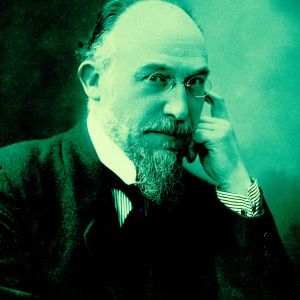
Erik Satie was a French composer and pianist, born on May 17, 1866, in Honfleur, Calvados, France. He is known for his innovative and eccentric musical compositions as well as his sardonic wit and contributions to the avant-garde art movements of his time.
Satie’s music represents a break from the Romantic tradition, characterized by its simplicity, precision, and a tendency towards satire and understatement. His most famous works include the piano pieces “Gymnopédies” and “Gnossiennes,” which have a meditative, almost haunting quality.
Satie’s work laid the groundwork for minimalist composition and had a significant influence on later composers such as Debussy and Ravel.
Satie’s relationship with absinthe is well-documented; he was a frequent patron of the bohemian cafés in Montmartre, where absinthe was the drink of choice for artists, writers, and musicians.
During the 1880s, Satie was deeply immersed in the Parisian café-cabaret culture, a milieu that was both a source of inspiration and a means of socialization. His consumption of absinthe was part of the larger cultural phenomenon of the time, which associated the drink with artistic creativity and nonconformity.
While it is difficult to measure the direct impact of absinthe on his work, the culture surrounding absinthe undoubtedly played a role in the artistic environment that shaped Satie’s unique musical voice.
Henri de Toulouse-Lautrec
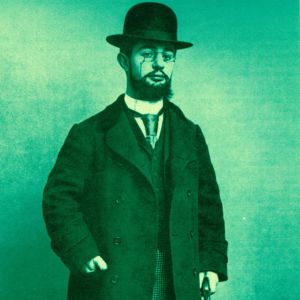
Henri de Toulouse-Lautrec was a French painter, printmaker, draftsman, and illustrator, whose immersion in the colorful and theatrical life of Paris in the late 19th century allowed him to produce a collection of enticing, elegant, and provocative images of the modern and sometimes decadent life of those times.
Born on November 24, 1864, in Albi, France, Toulouse-Lautrec is among the best-known painters of the Post-Impressionist period. He is particularly known for his works depicting the nightlife of Paris, such as scenes from the Moulin Rouge and other cabarets and theaters.
His style was influenced by the Impressionists and Japanese printmaking, and his works are characterized by their portrayal of the underbelly of Parisian society with a candidness and humanity that was ahead of his time.
Toulouse-Lautrec’s consumption of absinthe was notorious and he was a fixture in the Montmartre district of Paris, known for its bohemian lifestyle and being a gathering place for artists, writers, and philosophers.
Absinthe, often called “the Green Fairy” for its distinctive color and supposed hallucinogenic properties, was a popular drink among this artistic community, and Toulouse-Lautrec was no exception. He was known to create his own cocktails, famously mixing absinthe with cognac to create a potent drink known as “The Earthquake” (“Tremblement de Terre” in French).
Toulouse-Lautrec’s indulgence in absinthe and other alcohol is often cited as a contributing factor to his health issues and early death at the age of 36. His lifestyle and the subjects of his art were reflective of the bohemian and sometimes hedonistic atmosphere of the time, in which absinthe played a significant role
Edouard Manet

Édouard Manet was a pivotal figure in the transition from Realism to Impressionism and is considered one of the fathers of modern art.
Born on January 23, 1832, in Paris, France, Manet was known for his bold and straightforward approach to painting, depicting contemporary subjects often drawn from urban life, café culture, and the social activities of Paris.
Some of his notable works include “Olympia” and “Le Déjeuner sur l’herbe,” which challenged traditional artistic conventions and provoked public controversy at the time.
Manet’s works often depicted scenes of Parisian social life, including the café-concerts and the bars where absinthe was commonly consumed. While Manet himself was not as notoriously associated with absinthe as some of his contemporaries, the culture of absinthe drinking is reflected in his art.
For example, in his painting “The Absinthe Drinker” (Le Buveur d’absinthe), Manet portrayed a solitary figure lost in thought over a glass of absinthe, capturing the mood and atmosphere associated with the absinthe culture of the period. The painting is significant as it is one of his first major works and marks his break from traditional painting and the beginning of his journey towards modernism.
Manet’s engagement with the subject of absinthe drinking in Parisian culture is indicative of his broader interest in the realities and experiences of contemporary urban life
Recommended: 8 Absinthe Red Flags (Identifying the REAL Green Fairy)
Paul Verlaine

Paul Verlaine was a French lyric poet associated with the Symbolist movement who was born on March 30, 1844, in Metz, France. His poetry is known for its musicality, use of word play, and a melancholic tone, often reflecting the troubles of his personal life.
Verlaine’s work includes collections such as “Romances sans paroles” (Romances Without Words) and “Fêtes galantes,” which showcase his innovative use of rhythm and form and his delicate handling of language and emotion.
Verlaine’s life was marked by turmoil and tragedy, including a tumultuous relationship with fellow poet Arthur Rimbaud and a period of imprisonment. He struggled with alcoholism, and absinthe was among the substances that Verlaine frequently abused.
As we’ve already covered with others on this list, the consumption of absinthe was common in the literary and artistic circles of 19th-century France, and it often served as both muse and vice for many creative figures of the time.
Verlaine’s heavy drinking influenced both his life and his work, contributing to his reputation as a poète maudit (accursed poet), a term applied to a number of poets whose work was inextricably linked with their tormented lives.
Despite his personal struggles, Verlaine’s poetic achievements have left a lasting mark on French literature
Arthur Rimbaud
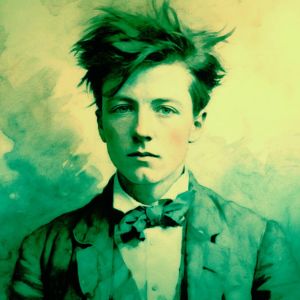
Arthur Rimbaud, the French poet renowned for his influence on modern literature and the symbolist movement, also had a relationship with absinthe.
Rimbaud was known for his rebellious lifestyle and his exploration of the boundaries of poetry. He was a part of the Parisian literary scene in the second half of the 19th century, a period when absinthe was immensely popular, especially among artists and writers who were drawn to its reputedly mind-altering effects.
Rimbaud’s poetry often delved into themes of decadence and derangement, and his personal life mirrored this as he engaged in a bohemian lifestyle, which included the consumption of absinthe.
His tumultuous and intense relationship with fellow poet Paul Verlaine, who was also known to partake in absinthe, further intertwined Rimbaud with the culture of the drink. The two shared a notoriously stormy affair that was fueled by heavy drinking, among other excesses.
While Rimbaud’s work does not focus heavily on absinthe as a subject, his lifestyle and the circles he moved in suggest that he was well-acquainted with the drink.
Absinthe was a fixture of the artistic and literary scene that both shaped and was reflected in Rimbaud’s work. His early and brief engagement with poetry was intense and innovative, and his subsequent abandonment of literature for a life of travel and trade in Africa has contributed to his legendary status in the world of poetry
Recommended: How to Prepare Absinthe the Right Way!
Aleister Crowley
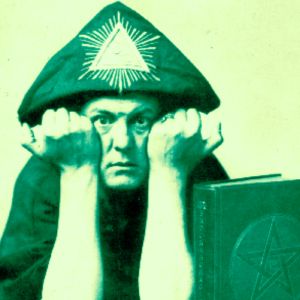
Aleister Crowley, often associated with the occult and mysticism, also had an interest in various substances, including absinthe.
In his writings, Crowley expressed his experiences and experiments with absinthe.
For instance, he wrote an essay titled “Absinthe: The Green Goddess” which reflects on his time spent in the Old Absinthe House in New Orleans. In this essay, he muses on the effects of the drink and the atmosphere of the establishment. This work is indicative of his broader exploration of consciousness-altering substances and their potential to unlock new realms of human experience.
Crowley’s affinity for and association with absinthe is further illustrated by the fact that a specific brand of absinthe, Absinthe Brevans A. Crowley, was named after him. This absinthe was designed to reflect Crowley’s tastes, with added cognac and then aging in oak barrels for several years, which is not a common practice for absinthe.
While Crowley’s primary legacy is his contribution to occultism and ceremonial magic, his engagement with absinthe and other substances also speaks to his larger quest for spiritual and sensory exploration.
The life of “the wickedest man in the world” was marked by seeking out extremes and testing the boundaries of human experience, and absinthe was, perhaps unsurprisingly, a large part of that journey.
Charles Cros

Charles Cros was not only a poet and inventor but also known for his relationship with absinthe.
His social circle included figures like Paul Verlaine and Arthur Rimbaud, who were also known for their absinthe drinking. Cros was known to frequent many of the popular Parisian cafés where absinthe was the drink of choice for the bohemian set.
He is mentioned in the context of absinthe culture and is said to have written a poem entitled “Lendemain” which surrounds the themes of love and absinthe, indicating a personal engagement with the drink that was so emblematic of the artistic and literary life in 19th-century Paris.
This connection with absinthe is part of the larger tapestry of the Belle Époque period in France, where absinthe was considered as much a muse as it was a social lubricant and recreational pastime
Guy de Maupassant

Guy de Maupassant, the renowned French author, is yet another brilliant creative who is known to have had a relationship with absinthe.
Maupassant’s works often reflected the society around him, and he was a part of the Parisian social scene where absinthe was very popular during the late 19th century. He was known to frequent the same circles as other famous absinthe drinkers like Émile Zola, Charles Baudelaire, and Paul Verlaine.
His experiences with absinthe are said to have influenced his writing. Some literary scholars suggest that the hallucinations and mental illness that afflicted Maupassant later in life may have been exacerbated by his use of absinthe, among other factors.
Absinthe was widely consumed by artists and writers of the time, who believed it stimulated creativity; however, it was also notorious for its high alcohol content and the presence of thujone, a chemical compound found in the wormwood plant used to make absinthe, which was thought to have psychoactive properties.
The lifestyle that included absinthe consumption was a hallmark of the bohemian life in Paris during the Belle Époque, an era that Maupassant’s stories often depict with critical insight.
His short story “A Queer Night in Paris” is a direct reflection of the absinthe culture and its effects on Parisian society. Maupassant’s connection to absinthe is therefore both personal and literary, representing a broader cultural phenomenon of his time.
Recommended: The Shocking Tale of “The Absinthe Murders”
Ernest Dowson

Ernest Dowson, an English poet associated with the Decadent movement, was known for his lyrical poetry and his troubled life, which included a relationship with absinthe.
Born on August 2, 1867, Dowson became one of the most gifted poets of his circle, which included other figures like Oscar Wilde and Aubrey Beardsley. His life was marked by a series of personal tragedies, including unrequited love and the early deaths of his parents, which led to his heavy drinking and financial ruin.
Dowson’s fondness for absinthe was part of the larger Decadent movement’s fascination with the drink, which was seen as a symbol of aestheticism and rebellion against the bourgeois norms of the time.
Absinthe was romanticized by the Decadents as a source of inspiration and a means to access greater artistic depths, despite its detrimental effects on health. Dowson’s excessive drinking, including his consumption of absinthe, contributed to his declining health and his early death at the age of 32.
In his work, Dowson often explored themes of love, beauty, and melancholia, and his famous lines “I have been faithful to thee, Cynara! in my fashion” from his poem “Non Sum Qualis Eram Bonae sub Regno Cynarae” reflect the passionate intensity that characterized both his writing and his life.
Dowson’s relationship with absinthe was, in many ways, emblematic of the Decadent poets’ broader embrace of transgressive and self-destructive behaviors as a form of artistic expression
Marilyn Manson

With absinthe’s comeback in recent years, it feels inappropriate not to include at least one modern well-known absintheur on our list. When it comes to artists who seek to embody the spirit of rebellion associated with absinthe in the days of old, it’s hard not to look straight at the shock-rocker who terrified entire countries.
Marilyn Manson, the stage name of Brian Hugh Warner, is an American rock musician known for his controversial stage persona and image as the lead singer of the band Marilyn Manson.
His relationship with absinthe is not only personal but also commercial. In 2007, Marilyn Manson launched his own brand of absinthe named “Mansinthe.” This venture into the absinthe market underscores his affinity for the drink, which complements his artistic aesthetic that often plays with themes of decadence and the macabre.
Mansinthe is notable for its traditional production method and high thujone content, the substance found in wormwood that was once thought to cause hallucinogenic effects.
The launch of his absinthe brand can be seen as a reflection of Manson’s interest in the history of the drink and its association with the bohemian and artistic lifestyles, as well as its reputation for being a rebellious and unconventional choice.
Marilyn Manson’s engagement with absinthe ties into his broader persona, which frequently invokes a mix of shock rock and gothic elements.
His music and performances often explore dark and transgressive themes, and the embrace of a historically notorious drink like absinthe fits well within the framework of his brand and the cultural references he invokes
Conclusion
As the last drops of our absinthe-soaked journey trickle away, we find ourselves at the end of a verdant voyage through time, where the Green Fairy’s most ardent admirers have made their indelible marks on history.
From the tortured verses of Rimbaud to the dark anthems of Marilyn Manson, absinthe has been the silent muse behind a cavalcade of cultural icons. It’s a legacy steeped in creativity, controversy, and a touch of madness—a fitting tribute to a drink that has always danced on the edge of society’s norms.
So, raise your glass to the luminaries who dared to sip from absinthe’s fabled chalice. May their stories inspire you to find your muse, in whatever form she may appear.
Remember, though the hour grows late and the bottle may empty, the spirit of the famous absinthe drinkers lingers on, as potent and enigmatic as the elixir itself.
Until we meet again, under the spell of the Green Fairy’s wings, santé!

